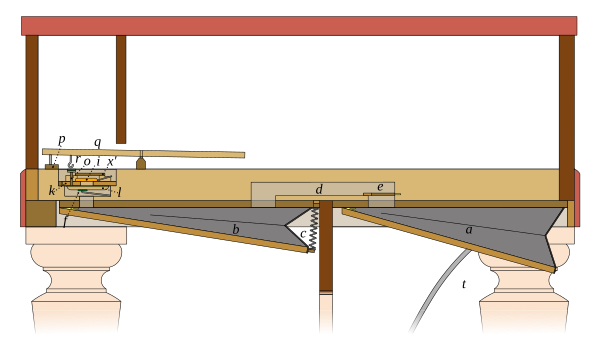Image: US3548 18440417 pianoforte fig1

Description: From patent specification: The construction is as follows: Underneath the bottom of the piano and covering nearly the whole of the rear half thereof, I place the “feeder” half (a of the bellows, which is constructed similar to that of the organ, but the “rise” (b) instead of being placed over the feeder, is situated in front of it, and is kept closed by spiral springs (c); these two halves of the bellows are connected by wind trunks (d), the riser opening in the same direction as the feeder, the valve between them being placed in the trunk over the feeder at (e). The wind chest (f) is a long narrow box, situated under the key board, forward of the fulcrum of the keys, and above it the reeds are placed (lettered (i); one is shown separately in Fig. 3) on the pallet board (k), which covers the wind chest, a communication with each reed being formed from the wind chest through the said board (k) which is stopped on the underside with a pallet (l) that is kept closed by a light spring; on the end of the pallet opposite the hinge, a stick down or wire (o) rests, that extends up through the pallet board (k) and bottom of the piano, to the level of the bottom of the rail (p) of the keys, where it ends in a button, the top of which is covered with cloth; from each of the keys (q) a wire (r) projects downward to meet the button above named, the end being bent into an eye which rests thereon, so that when the key is pressed down, it shall carry with it the wire (o) and thus open the pallet to its corresponding reed; by this construction the keys can be removed without difficulty and the wire (r) serves to regulate the opening of the pallet by screwing into the key. ... The feeder of the bellows is worked by a pedal (s)[not shown in edited image] connected therewith by a rod (t). The feeder and riser can be placed one above the other, but in that case they disfigure the instrument by projecting below the bottom of it, and cannot be packed with the same facility for transportation. It will be obvious that any other form of bellows could be used to supply the wind, but for compactness I believe the form I have adopted to be the best. I have used two feeders each with a treadle, without any riser to be worked alternately, thus keeping up a steady blast and producing the swell with the foot, but I ordinarily produce the swell by putting a thin board over the reeds and forming a box which can be raised by means of a pedal. (This is shown at (x’) Fig. 1.) ...
Title: US3548 18440417 pianoforte fig1
Credit: Fig. 1, Obed M. Coleman, Pianoforte United States Letters Patent No.3,548, April 17, 1844
Author: Obed M. Coleman, traced and edited by User:Mireut
Usage Terms: Public domain
License: Public domain
Attribution Required?: No
Image usage
The following page links to this image:

